The Lesson of a Garden, by William Bronson
From: Cry California, The Journal of California Tomorrow
Winter 1970-1971, Volume 6, Number 1
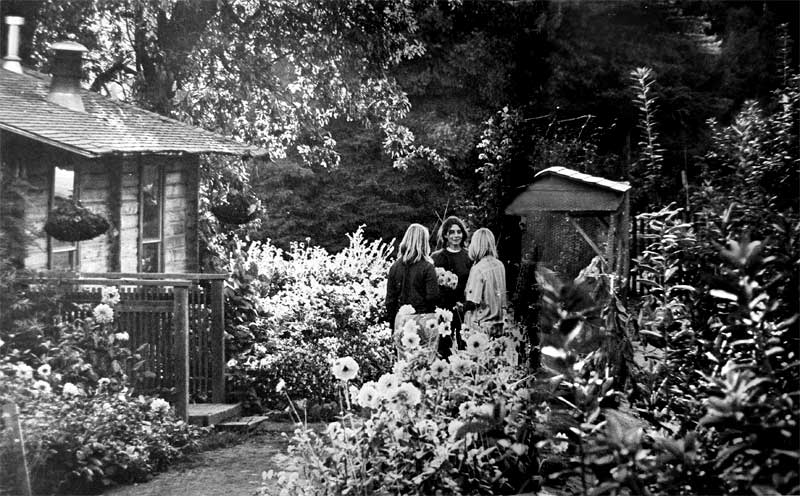
Students pause in the morning light on their way to breakfast at the chalet. The pet doves kept in the aviary fill the day with the music of their muted cooing.
There is a student-run garden on the campus of the University of California at Santa Cruz which puts forth flowers and vegetables in an abundance and with a vigor that simply must be seen in person to be fully comprehended. To me this demonstration, this dazzling year-round fertility rite, has long-term implications which, while not entirely clear, may well prove to affect the lives of thousands, perhaps even millions, of Americans as the years go on.
The word “revolutionary” is both easy and dangerous to throw about these days, but it is surely appropriate to use it in this context, for the dedicated young people who are responsible for the garden have not only succeed in producing flowers and vegetables on a four-acre hillside plot in quantities many times―at the very least, four times―greater than are realized in commercial agriculture, they have created an on-going institution with a sense of purpose, a sense of hope, a sense of community, and a pervading sense of sanity which today so many other of our institutions and activities lack in one degree or another. While many of these students may feel the outrage that has driven so many others on so many campuses in so many different, often tragic, directions, the basic motivations at Santa Cruz appear to rise from quieter wellsprings.
How it started
The garden idea originated in conversations at Santa Cruz between Donald Nicholl, a visiting professor of history from Keele University in England, and Paul Lee, a professor of philosophy on the Santa Cruz faculty. The two shared a temporary mobile-home office in the spring of 1967, the second year of the young campus’ history. The physical nature of what the campus was to become concerned them both, and in Lee’s words, Nicholl “mourned the institutional imposition on a great landscape and wondered how we would ever develop a sense of place here.” From this speculation came the garden idea, a garden that would redeem the landscape. The idea was broached to chancellor Dean McHenry and, with his blessing and active promotion, the project was launched. By chance, Countess Freya von Moltke, a widow of a famous World War II German general [** see note below], was visiting the campus and told Lee that a friend of hers from England by the name of Alan Chadwick was soon to come to Santa Cruz and suggested he would be an ideal person to found the garden. Chadwick’s long years of experience in intensive horticulture and his philosophical commitment to the objectives of the project made him, indeed, an ideal choice. And so Lee hired him. The garden project began with Chadwick buying a shovel, selecting the site at the entrance to the college, and attacking the job of turning the unlikely slope into the garden that thrives so gorgeously today. Under Chadwick, the student cadre and leadership grew.
[** Ed. note: Helmut von Moltke was "famous" because he worked from within the German military against Nazi policies and was executed by Hitler for his role in opposition to the objectives of the Third Reich.]

The student garden project grounds, uppercenter, rise on a slope above the main campus road to the UC Santa Cruz campus close by three of the university’s colleges: Merrill College, top; Adlai E. Stevenson College, bottom; and Cowell College, center left..
It is my observation that most, if not all, the students connected with the project are committed to it on philosophical grounds. In addition, while religious commitment is not necessary to successful gardening, as those in the project will readily agree, it certainly doesn’t hurt. Once revved up by a few probing questions from a doubter, Alan Chadwick will speak with fervor about his beliefs which link God and nature and man, and man―the meddler, the destroyer―always comes out third best. The natural interaction of the lower orders forms the model for all garden practices.
Steven Kaffka, who as an undergraduate was for two and one-half years president of the garden project and is now one of four paid staff members, tells of the working attitude which has grown up in the project:
“We grow things for the joy of doing it, and the perfection of the crop itself, not for volume as a commodity in trade. If you seek profit, your success every time is less than if you grow for beauty and the love of doing it. “The end is implicit in the activity and is not the motivation for it. Classical horticulture is purely professional, there are no shortcuts to detract from the well being and culture of the plants, whose interest and health are primary. We base our action on those ideas. We plan our work around the garden, we don’t work the garden around us.”

The garden site
The garden is located on what seems an unlikely spot―a very steep slope above the embankment of the main entrance road to the camps. A mixed forest once stood here - redwood, Douglas fir, madrone, tanbark oak, hazel, huckleberry, fern and oxalis. Almost 300 years ago a severe fire burned through, but the great trees survived, only to fall to the logger’s ax in the late 19th century. Today, a couple of fine second-growth redwood rings and scattered madrone and Douglas fir remain as evidence of the original fog-nourished stand. The fog, of course, is still with us, as it is most of the summer along the Northern California coast, and this makes the abundance of the garden an even greater wonder. It is interesting to know that the soil at the garden site was thought by the campus landscape architect to be a poor prospect for growing what was planned for a garden.
Of the four-acre plot, about half an acre is planted in vegetables, another acre and a half in flowers for cutting, perhaps another acre in other flowering plants, and the balance is either densely tree-shaded or used for such things as the nursery, compost piles, chicken yards and the like. About half an acre of steep bank is the only significant part of the plot remaining to be developed.

The gardener’s day begins at sunrise. The major work before breakfast is cutting flowers for the university’s offices and residences.
The French Intensive Method
There are some basic observations about the “French Intensive Method” (as Chadwick calls this school of organic gardening) which are central to the garden’s success.
First off, the soils in the garden are constantly enriched. Initially, nitrogenous crops such as fava beans were set out, and the planting beds were dressed between each crop with two-year-old composted manure - untreated and right from the farm, quite different from the bagged product you get at the supermarket. Bone meal is added to each bed, but in smaller quantities than during the first two years. Wood ash was and is used for many vegetables. As much compost as could be acquired or made was worked into the beds initially, and composting remains a regular and important part of the soil-conditioning process. Each time a bed is reworked for sowing or planting, the soil is improved, and oftentimes it is even richer after the crop has been grown and harvested. (I noticed during my first visit to the garden that the organic materials used to enrich the soil are always referred to as nutriments, rather than nutrients. I confess that I wasn’t certain that “nutriment” wasn’t merely a corruption of “nutrient”, so I looked up both in the dictionary. According to Webster’s Collegiate, a nutrient is a nourishing substance or ingredient,“ while a nutriment is "something that nourishes or promotes growth and repairs the natural wastage of organic life.” I doubt that I’ll ever forget this elegant differentiation.)
One of the striking differences between commercial agriculture and the French Intensive Method is the absence of row planting in the latter. Row planting facilitates large scale irrigation and machine cultivation, but in terms of production it is very wasteful.
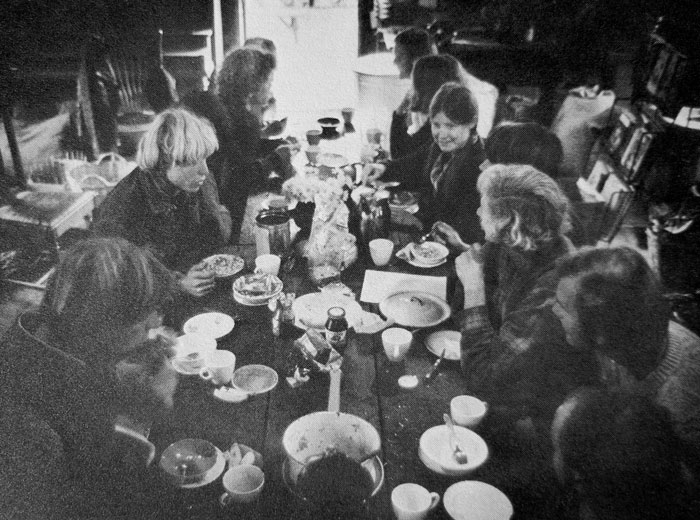
Plans for the balance of the day’s work are discussed at the chalet during breakfast, which was served indoors on the chilly, foggy morning the picture was taken. Weather permitting, meals are generally served on the adjacent deck.
Planting patterns in the Santa Cruz garden and the resulting micro-environmental benefits were described by Steve Kaffka in these words:
“Because the plants are set close enough to each other so that as they mature they touch or nearly touch, the ground is shaded and protected from direct sunlight; naturally the roots are quite close, as are the stems and stalks. In the spaces between there exists a greater evenness of temperature and moisture than it is possible to attain by row planting and each plant, because of the proximity of its sister plant, seems able to create a climate around itself that it prefers, both in the air above the ground and in the soil below the surface. In the critical zone, which is that area three inches around the base of the plant, one inch below and two inches above the surface of the soil, we attempt to maintain conditions of temperateness, free-breathingness, openness and healthy growth.”
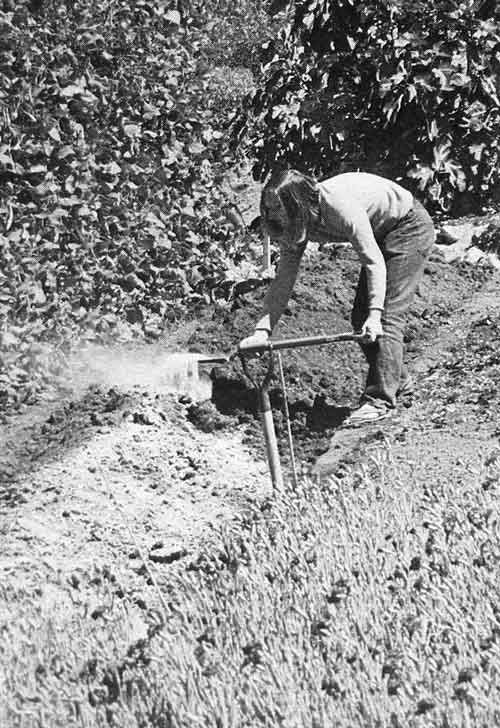
A bone meal dressing is applied to one of the vegetable planting beds prior to the sowing of the next crop. All beds are kept in year-round production.
To make the most of the sunlight available, most of the vegetable planting beds run up and down the hill to maximize the southern exposure. The first question that came to my mind was how they kept the hillside from washing away. The secret lies in the frequent, careful watering practices and in a very simple soil-conservation technique. The little soil that is washed into the paths at the foot of the beds is either wheelbarrowed up to the top of the bed or spread on the compost piles. In either case, the soil is returned from whence it came.
There is no off-season for the garden. As soon as a vegetable bed has been harvested or a flower bed ceases to yield sufficient blooms, it is reworked and a new planting is made. Visually the garden is an overwhelming carpet of color and texture and during the day fairly hums with the activity of insects and birds. The variety of species planted is extraordinary, although certain favorites—dahlias and lettuce, for example—occupy more space than many others.
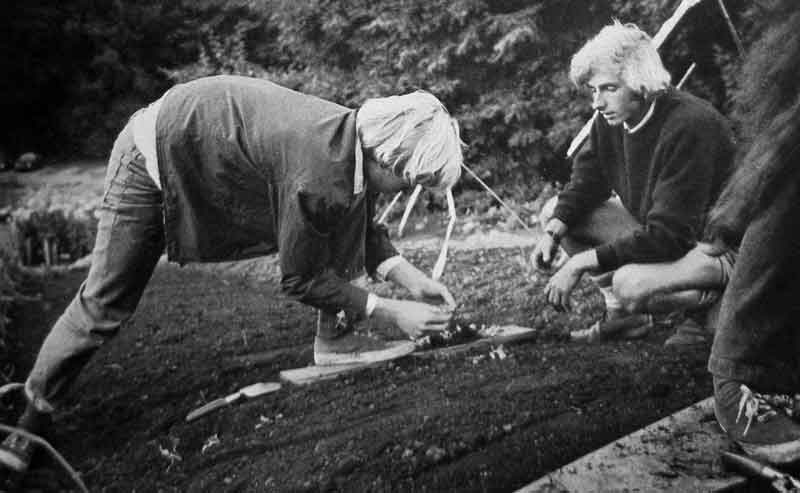
A beginning gardener, with his foot planted on a board to keep from compacting soil in the carefully prepared bed, transplants cabbage seedlings under the instruction of staff member Steve Kaffka. Transplanting is done in the evening hours.
A Gardener’s Day
Work in the garden begins shortly after sunrise and ends as darkness falls. The hours, of course, vary with the season and the weather, both of which also have a great bearing on the nature of the chores. The staff works all through the day, and the students come and go as their academic schedules allow. At 9:15, a half-hour is taken for breakfast at the chalet, an airy, one-roomed decked cabin which serves as kitchen, dining room, office, and gathering place. During breakfast, which anywhere from six to twenty students and staff will join, depending on the weather and proximity to finals, plans for the day’s work are often discussed. After breakfast, the gardeners spend the rest of their long day planting, weeding, harvesting, watering, feeding the chickens and attending to all the other needs appropriate to the day and the season. A big lunch is set out at one o’clock and tea (or high tea if garden business is to be discussed) is served at 4:30. After tea the work goes on till dark.
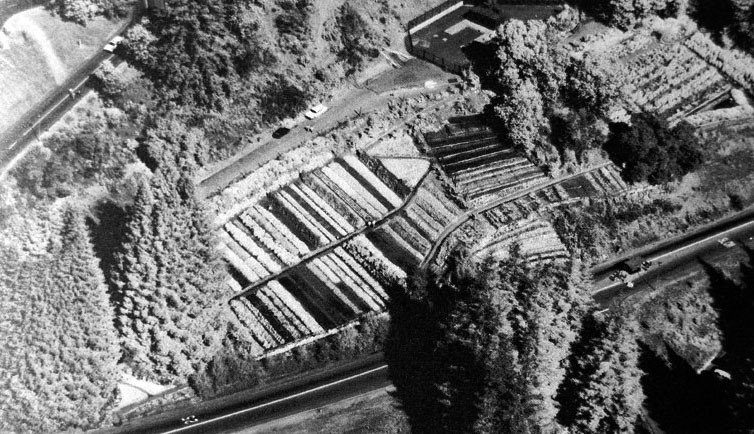
Aerial close-up of the garden, above, shows the actual planting beds referred to in the chart, left; the vegetable beds lie diagonally in the exact center of the photo. Much of the balance of the garden is devoted to annual and perennial flowers; herbs, berries, and fruits; and, out of sight on the right, henhouses.
Mealtime is about as unplastic an eating experience as you can find in this country today. The students do the cooking which includes baking their own bread, and a spirit of easygoing camaraderie prevails across the groaning board. Much, but not all, the food served at the chalet is grown in the garden. Bounteous as the yield may be, the garden doesn’t produce a fully balanced diet. Fruits, grains, fats, and other staples such as milk and cheese, and wine for special occasions, are purchased on the outside.
The food is simple, abundant, good-tasting and, without question, healthful. Most of the meals are meatless, although fish is sometimes served. But even for me, a lifelong meat-eater, the inner man was fully satisfied by the meals I enjoyed as a guest at the chalet. As far as I could see, work in the kitchen is carried on with little formal discipline or direction, but anarchy or not, all the dishes were served up at one time in grand style.
TYPICAL GARDEN PLANTING SCHEDULE
The charts below show schematically the 1970 planting schedule for 18 of the project’s 28 vegetable planting beds. The words “early”, “middle,” and “late” indicate the time of the month when planting or sowing was done. Dates for crops planted in previous years appear with the January Listings.
BED |
1 |
2 |
3 |
4 |
5 |
6 |
7 |
8 |
9 |
JANUARY |
Leeks |
Leeks |
Fava Beans |
Leeks |
Lettuce |
Leeks |
Cauliflower |
Cabbage |
Lettuce |
FEBRUARY |
|
|
|
|
|
Cabbage |
|
|
|
MARCH |
|
Cauliflower |
Celery |
|
Spinach |
|
|
Lettuce |
Carrots |
APRIL |
|
|
|
|
|
|
Bush Beans |
|
|
MAY |
|
|
Lettuce |
Celery |
|
|
|
|
|
JUNE |
|
|
|
|
Leeks |
Leeks |
|
|
|
JULY |
Fava Beans |
|
|
|
|
|
|
Brussels Sprouts |
|
AUGUST |
|
|
Leeks |
|
|
|
Lettuce |
|
|
SEPTEMBER |
|
|
|
|
|
|
|
|
|
OCTOBER |
Cauliflower |
|
|
|
|
|
|
|
|
NOVEMBER |
|
Cabbage |
|
Cauliflower |
Lettuce |
|
|
|
|
DECEMBER |
|
|
|
|
|
|
|
|
|
BED |
10 |
11 |
12 |
13 |
14 |
15 |
16 |
17 |
18 |
JANUARY |
Beets |
Brussels Sprouts |
Brussels Sprouts |
Cherry Tomatoes |
Beets |
Scarlet Runner Beans |
Radishes |
Lettuce |
Scarlet Runner Beans |
FEBRUARY |
|
|
|
White Beets |
Potatoes |
|
|
Cabbage |
|
MARCH |
|
|
Carrots |
|
|
|
Carrots |
|
|
APRIL |
|
Radishes |
|
|
|
|
|
|
|
MAY |
Lettuce |
|
|
|
|
|
|
|
|
JUNE |
|
Brussels Sprouts |
|
|
Lettuce |
|
|
Lettuce |
|
JULY |
|
|
|
|
|
|
|
|
|
AUGUST |
|
|
|
Cauliflower |
|
|
Cabbage |
|
|
SEPTEMBER |
Carrots |
|
|
|
|
|
|
Chard |
|
OCTOBER |
|
|
|
|
Spinach |
|
|
|
Lettuce |
NOVEMBER |
|
|
|
|
|
|
|
|
|
DECEMBER |
|
|
Lettuce |
|
|
|
|
|
|
Pest Control
Like soil enrichment, pest control is pursued entirely without synthetic chemical tinkering. Occasionally, the aphid population may get out of hand on certain crops, such as Brussels sprouts, and if the natural predators fail to move in, nicotine sulphate (a highly toxic, plant-derived, non-persistent insecticide) is sprayed on the plants. Other than this, and the control of snails and slugs by hand, pest control is left to nature.

Students arrange the morning’s flower harvest for other students and faculty to pick up later on at the kiosk located on the road below the garden.
These are Steve Kaffka’s thoughts on the subject of letting nature work and helping nature work to achieve the optimum garden:
“The word ‘pest’ needs redefining. In nature there’s no such thing. There are balances in nature which work to maintain healthy plant life - insects, birds, animals, each has its place. The gardener following the principle of simulating nature seeks to preserve the balance. If this is done, the word ‘pest’ doesn’t enter the picture. Our garden is a bird sanctuary, we have more birds this year than ever before, they increase every year. To encourage the birds to come and stay, we allow weeds such as groundsel and dandelion to remain and go to seed, then the birds eat the seeds. Many birds, such as juncos and canary warblers, are both seed and insect eaters. We provide birdbaths and water troughs and let them drink unmolested. We also try to discourage the presence of cats for the sake of the birds.
“When you don’t use pesticides and poisons, you frequently have insects such as mantis and ladybugs which prey on destructive insects. Each year, the harmless insects increase in number, as do the birds which feed upon them. Each year without poisons makes life more possible and plentiful for all.
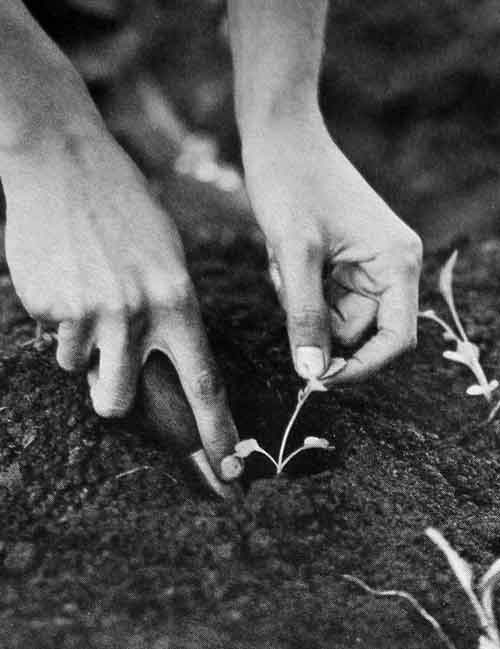
Under the French Intensive Method of gardening, seedlings are spaced close enough together so that, as mature plants, whey will form a complete cover over the soil. Note the rich, crumbly nature of the soil.
Phases of the Moon
One of the more fascinating aspects of the French Intensive Method is the attention given the phase of the moon when it comes to determining the time to sow and transplant. Project members are quick to tell you that sowing and transplanting by the moon were ritually practiced in much of the world for millennia prior to the 20th century. Sowing is always done on the inclination of the moon - that is, the seeds are put into the ground at the time of the new moon, or perhaps even a few days before, in order to take advantage of the growing brilliance of the moon during the two weeks it takes for the full moon to arrive. (How the light gets through the soil to hasten germination eludes me, but the world is full of mysteries.) Transplanting, on the other hand, is done in the evenings during the declination of the moon - that is, the two-week period between the full moon and the new moon.
[Ed. note: The gravitational forces of the moon, rather than its light, were seen by Chadwick as the influence on seed germination. The moisture within the seed is affected gravitationally by the moon in the same way that the ocean's tides reflect the 28 day lunar cycle.]
Now, while I don’t personally think the moon has a lot to do with the success of this or any other garden, this garden is so eminently successful that I would, were I teaching the French Intensive Method, indoctrinate my students with the moon-planting rules as gospel, even though I might keep my doubts. At most, it certainly doesn’t hurt anything to sow during the new moon and transplant during the full. Before we leave this point, and without intending to mock the practice, I can’t resist repeating Calvin Trillin’s account of a ritual he observes while flying which he wrote in an article called “A Travelling Person on a beautiful Place” (The New Yorker, March 4, 1970).
“When I woke up, we were about to land in Los Angeles. I looked at my watch and saw that we were right on schedule at fifteen minutes after midnight - New York time, of course. Although Travelling People are beyond superstition and long ago conquered any fear of flying, I happen to know that setting my watch ahead during a flight could cause a crash. Or at least not setting it ahead has always prevented one.”
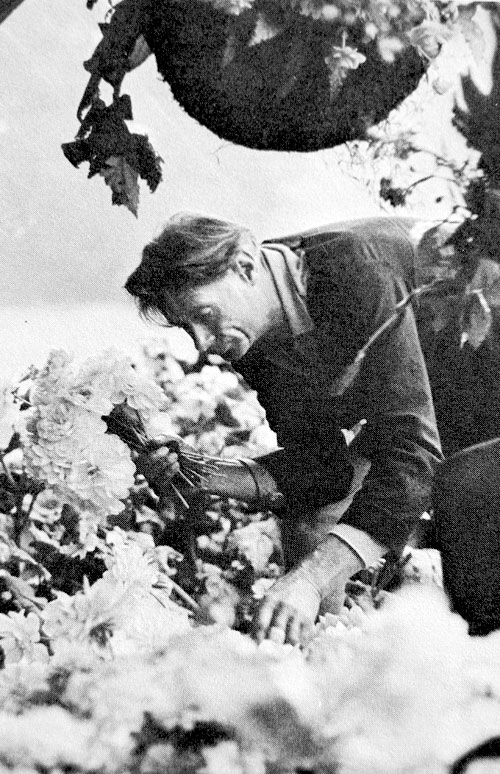
Master horticulturalist Alan Chadwick, who directed the student garden from its inception, is shown here arranging dahlias at the roadside kiosk.
The garden in our future
So successful has the project been that the university administration has granted 20 acres to the students, to found a model farm which would be developed on the same principles that guide the existing garden project. We often speak of relevance these days, and question the purpose and meaning of existing educational programs. If the garden project and the proposed model farm are not relevant, purposeful and meaningful in terms of the development of your young then nothing in this world is.
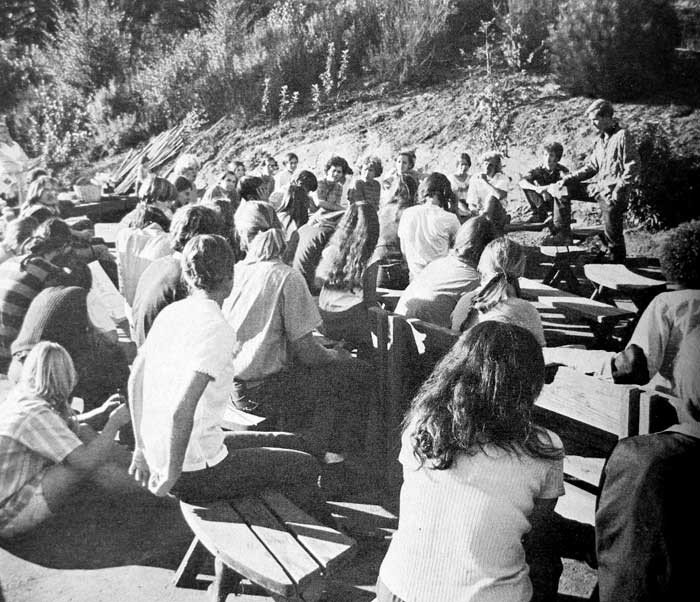
Student garden project president Dan McGuire discusses with other project members plans for a proposed model-farm program which would greatly expand on the garden-project concept.
In writing to the National Science Foundation for the funds necessary to get the model farm in operation, Dan McGuire, a sophomore and current president of the Student Garden Project wrote:
“...students will find in their work much of the meaning that Western civilization has lost in education - the affinity with nature that was once the root and basis for all higher learning. To be in affinity with their environment and to produce part of what they consume will give students a perception of life they often do not discover in the usual university curriculum.”
One of the great things the Santa Cruz program could do would be to train an army of inspiring teachers who could help spread the garden concept across the state and nation. I strongly believe that the state, with the university leading the way, should bring the garden-project idea to every community within its borders, and I suggest that the program contain the following elements:
- Every grammar-school district should have a garden which could be visited and worked in at least once a week by every child in the school.
- Every college campus and every high school in the state should have a garden project which would function not as a sop or a distraction but as a retreat and a locus of learning. While classes should be given for credit, participation should be open to all, with or without formal enrollment.
- University Extension should begin garden projects for the hundreds of thousands of older people who, given the chance, would throw themselves into intensive gardening training. The demand for this has already been established in the Santa Cruz experience. So many townspeople came to work in the campus project that the original rules allowing outsiders to work in the garden had to be changed.
The potential for change in American life that could result from such a program is great. The possibilities include a renascence in urban gardening and home food production which, among other things, might contribute much to the solution of our anticipated “leisure-time” problem. (It could, at the same time, go far in redeeming a substantial part of the many hundreds of thousands of acres of prime agricultural land in California alone which we have unwisely squandered on urban development, by returning the soil to the use for which it is best suited: growing food.) It clearly suggests the possibility of re-establishing, to some degree at least, a Jeffersonian rural lifestyle, that of the small freeholder living on the fruits of the land and his labor, which has virtually vanished from American life. Even the implications for commercial agriculture can’t be dismissed, although how the French Intensive Method, with its strong demand for hand labor, could fit into present-day agriculture is not at all clear.

A partially harvested lettuce bed between two heavy-bearing scarlet runner bean hedges.
* * *
There are a lot of young people out there, walking through our nights looking for the pill that will make manifest the fantasy world of their childhood, that world promised by Zorro, the Wonderful World of Disney, Superman, and the rest of the fascinating trash we let them feed on. There is no pill, of course, and lives are being wasted in the search. I can only speculate on what today’s lost young people might have been doing if they had had the opportunity to work with their hands in the soil and to learn the way the earth puts forth its bounty.
If we can teach mathematics and woodworking and music, surely we can give the young the opportunity to discover the earth which nurtures them. Perhaps it is wishful thinking to believe that the world might be changed for the better thereby, but God knows no harm cold come from our embarking on such a program.
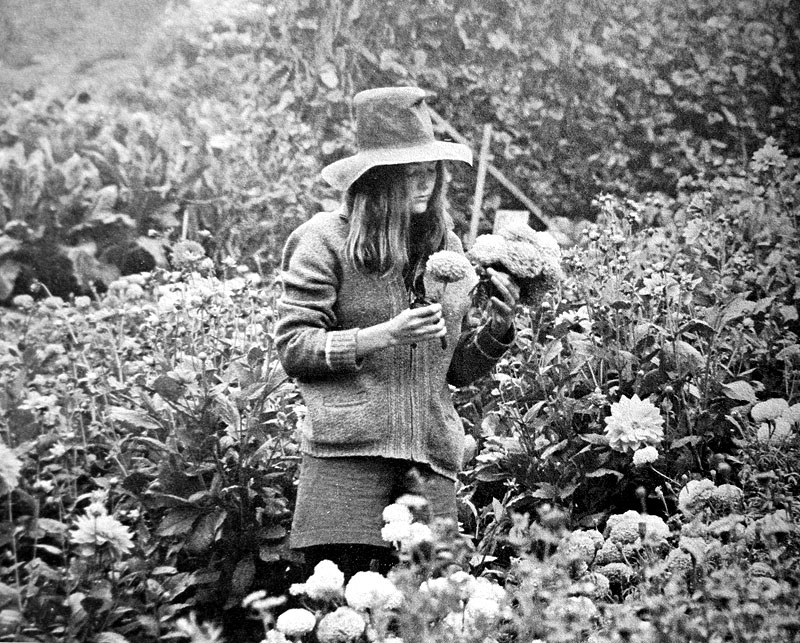
No one who has seen the UC Santa Cruz student garden can doubt the enrichment of campus community life which has resulted therefrom.
* * *
“To Rescue for Human Society the Native Values of Rural Life”
Joseph F. Williamson
The following reflections on the UC Santa Cruz Garden Project are taken from a speech given by Mr. Williamson, garden editor of Sunset, which in March, 1969, carried the first major story to be published on the project. The speech was given at a regional convention of the Garden Clubs of America in Burlingame on April, 30, 1970.
...those kids over there are trying to tell us something —something that hasn’t made the papers yet.
What they are trying to tell us is that the new generation of young adults is now coming along to take on the art and pursuit of peasant agriculture (what we call gardening) with an enthusiasm and involvement that people now over 30 can barely realize.
Imagine the scene there. A big new university an hour and a half from San Francisco. And ten minutes from downtown Santa Cruz–and when you get to downtown Santa Cruz, where are you? Nowhere. A wise chancellor and several wise liberal arts professors hatched the idea that those students could benefit from or would use a student garden project—a place where students could grow cut flowers and vegetables by the daily armfuls.
In my college years, such an idea would have been laughable. If any young male liberal arts major had ever said out loud that he’d really like to grow or cut some flowers or vegetables, rigid-minded, Atlas-oriented peers would have turned on him and called him a sissy or a queer or both and worse...
When I was a boy growing up in Berkeley, Hilgard Hall was the westernmost building on the campus and a person going along Oxford or Hearst streets could see it easily. If his vision was good, he could read the inscription along its fascia. Today you can still see it, but you have to squeeze in behind a lot of other buildings to find it.
The inscription says, “To Rescue for Human Society the Native Values of Rural Life” Hilgard Hall was then the seat of the university’s College of Agriculture, so that had to be the creed, official or unofficial, of the University of California College of Agriculture then.
Today, the College of Agriculture is devoted to hybridizing, designing, and developing crops, machines and methods that will increase the profits for big agriculture.
Meanwhile, over there in Santa Cruz we have liberal arts students learning about the good things that our peasant ancestors developed over the centuries—the native values of rural life—barred Plymouth Rock chickens that are handsome to look at and lay good eggs and taste good themselves when cooked; strawberries with a marvelous wild taste, even though they man hot look like much; tomatoes that are tasty even though they must be picked by hand.
Crazy isn’t it? The rescuing for human society of the native values of rural life no longer comes from the College of Agriculture, as someone intended, but from the Department of Philosophy at Santa Cruz, as practically no one intended.

As shadows begin to fall, a pretty lass prepares to serve afternoon tea, a daily ritual for the garden project workers.
Return to the top of this page
